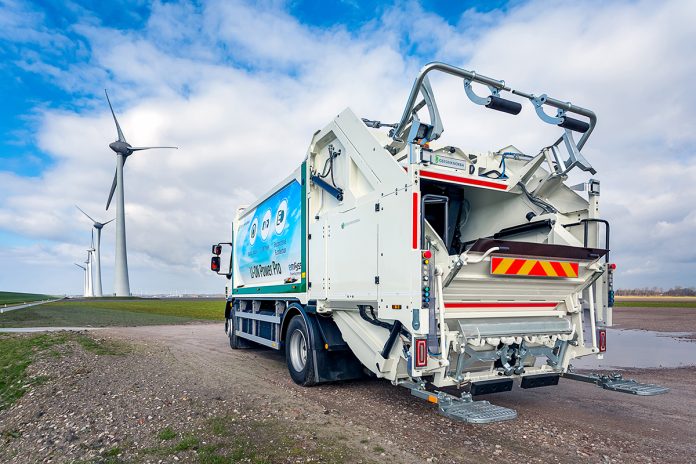Electric solutions for waste collection fleets are no longer pie-in-the-sky, writes Stuart Cudden from RCV manufacturer Geesinknorba
At Geesinknorba we recognise the urgent need to take action to reduce greenhouse gas emissions and improve air quality across the UK and the European Union (EU). According to UK Government figures, the transport sector is the biggest contributor to GHG emissions in the UK. Moreover, despite a drop of more than 40% in overall emissions since 1990, emissions from the transport sector have only fallen by 2% over the same period. Transport is also responsible for a third of all the UK’s NOx emissions, which have been linked to adverse health effects including reduced life expectancy. Putting cleaner vehicles on the road is vital to reducing the impact of this sector on the environment and public health.
Geesinknorba have been pioneering the development of electric solutions for the waste management industry since 2003. Based on lead acid batteries, our first hybrid refuse collection vehicle body won Vehicle of the Year at the CIWM (Chartered Institution of Waste Management) Awards for Environmental Excellence in 2009. Since then we have continued to develop the technology, and our first Li-On Power hybrid was launched in 2013. Truly a next-generation hybrid, the Li-On Power RCV runs on lithium-ion batteries that power the body and the lifts. Offering a high payload, reduced fuel consumption, and near-noiseless collection and compaction of waste, the vehicle can run 24/7 as the battery is recharged automatically while driving, only needing a ‘plugged-in’ charge once a week.
But our goal was and still is to make waste collection totally emissions free. An RCV uses on average one litre of diesel per kilometre travelled. According to the EU’s VECTO tool, one litre of diesel produces 3.13kg of CO2. If an RCV averages 100km a day, it is producing 313kg of CO2 every single day it is in use. Assuming an RCV operates approximately 260 days a year, the potential emissions savings of converting just one vehicle to full-electric operation are equivalent to 81.4 tonnes of CO2 annually.
The opportunity to make a real difference to both air quality and GHG emission is why, in 2017, we launched the first-ever full-electric RCV, the Li-On Power Pro. This ground-breaking technology for the first time offers public and private waste fleet operators the option of a zero-emissions waste collection vehicle. With the introduction of the Ultra-Low Emission Zone (ULEZ) in London and many other towns and cities in the UK expected to follow suit, the need for vehicles that meet the stringent requirements of these zones is only going to increase.
Of course, the source of the electricity must also be taken into account when considering total well-to-wheel emissions. With an increasing number of local authorities in the UK investigating renewable energy generation at their depots, and with 50% of the UK’s electricity now from low-carbon sources, the possibility of powering these vehicles entirely using ‘clean’ energy is becoming more realistic.
That’s not the only benefit of our Li-On Power Pro technology. Unlike electric cars, where many buyers are put off by range anxiety and lack of charging infrastructure, waste and recycling collection, particularly urban collection, is the ideal scenario for electric vehicles. Our Li-On Power Pro RCV is extremely energy efficient, easy to handle with no compromise in performance, and can easily achieve the required shifts. Thanks to its low-noise operation, it can also operate in the early mornings and at night, contributing to an all-round better living and working environment.A major advantage is that the Li-On Power Pro is a chassis-independent system that only requires a high-voltage connection and CAN bus connection from and to the chassis. The single power source for both chassis and body means there is no need to carry additional battery packs. Combined with the compact and lightweight batteries and the weight reductions achieved through the removal of the diesel engine and fuel tanks, this results in a high payload capacity.
The intelligent LPP module connects with any electric chassis, available from manufacturers such as Emoss, DAF, Man, Mercedes-Benz, and Iveco, and it controls the body dynamically for highly economic energy consumption. In combination with the energy-saving design of the GPMIV waste collection body, our electric RCV uses approximately 1.4kWh per tonne of collected, compacted, and dumped waste – a figure that has been verified by trials across the UK in locations including London, Leeds, Stockton-on-Tees, and Sheffield. In fact, there are currently 12 vehicles out in the field with customers, and general feedback is that both the chassis and body are exceeding expectations.
This means it is significantly cheaper to operate than a diesel, helping to offset the higher cost of acquisition. Results from trials indicate an average daily running cost of between £14 and £18.50 (~€15.50 to ~€20.50), depending on location, with average daily distances travelled between 88km and 175km. At current UK diesel prices, that’s a daily cost saving of between £113 and £216 (~€125 and ~€240) per vehicle and up to £56,000 (~€62,000) per vehicle, per year
Then there are maintenance costs to consider. An electric vehicle has fewer moving parts; there’s a lot less that can go wrong. Particularly with a direct drive, maintenance is significantly reduced.
In short, the sums add up. The total cost of ownership of a full-electric RCV is lower than a diesel, the performance is the same or better, and the environmental benefits speak for themselves. These vehicles are not only a good investment financially; they are an investment in the future.
Please note: This is a commercial profile











